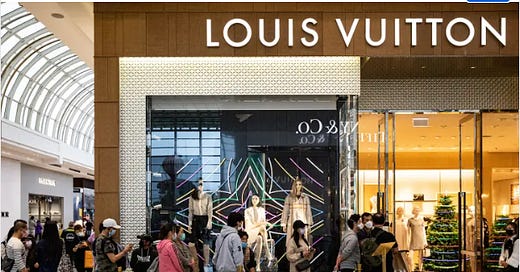Why we need a 3D internet. Or, my hopes for the future of online shopping and the FROW.
Not a predictions post. Not really, anyway.
No more metaverse?
OK, fine, I’m leading with a prediction- because everyone does ‘em, and I’m nothing if not a trend-lover- I’m going to use the term “metaverse’ a whole lot less in 2023.
Personally, I feel comfortable with the ambiguity of the term, bandying it about to serve my purposes, BUT many people like things to be a bit more black and white, and for them, I (and many others, I presume) will endeavor to be more precise this year.
Benedict Evans wrote a great piece on this - “saying ‘metaverse’ is rather like saying ‘mobile internet’ - it’s just the internet, on a new screen. New devices probably mean new platforms, and probably also mean some new gatekeepers.”
Of course, metaverse is not just a new screen; it’s an immersive, multi-player digital content machine. (you can see why metaverse is more fun to say)
You need the metaverse to have a FROW
And why is this word choice such a big deal? I fundamentally believe that this evolving immersive, 3D internet gets closer to the way humans prefer to interact. Since seating charts in the middle ages, with the most powerful next to the king and your table position from there giving away your relative power, humans intuitively understand that proximity MEANS something. If that example was a little too literary, think of fashion shows, the whole mania/memes around FROW (front row seating) revolve around wanting to be in the prime location and, crucially, have everyone else know you’re in the prime location. A 3D internet allows for prime locations or, at least/in particular, the appearance of prime locations. And visible queues. We all know the power of a visible queue.
It also allows for more natural exploration. Things are under and above, even behind. This type of discovery is more intuitive. To tie it back to online shopping, as I’m wont to do, intuitive discovery brings the chances for delight known so well in boutiques and in supermarket checkout aisles into the heads of e-comm UX designers.
Luxury needs depth and discovery
A 3D internet is deeper, and depth creates luxury, which is key when delineating and defining types of brands in pixels and online worlds. When you go into a luxury boutique, let’s say Louis Vuitton on the Champs Elysees, there are so many inputs at work to tell the brand story. Lighting, scent, temperature, salespeople’s looks and demeanors, what the building looks like inside, and the plushness of the carpet. Some of these are recreateable, some are not, and there will be new markers for luxury and exclusivity that are digital only.
Speaking of new luxury/exclusivity indicators, genuinely amazing, immersive worlds mean more demands on creators. Creating 3D on the various platforms in this space, e.g., Decentraland, Roblox, etc. isn’t easy; it takes an entirely new skill set. Once the novelty wears off, we’ll be able to recognize the wheat v the chaff in these skill sets and ascribe value accordingly.
Digital gaming has, of course, worked under these auspices for years. Quests and battles are more engaging when it’s clear how much land you are covering/taking/crossing/other-verb-ing, and a 3d, immersive world makes this salient.
The immersive internet evolution also leaves open the question of AR and VR. As someone who loves online shopping, obvi, (see my Christmas round-up of immersive e-comm here), I can imagine how an immersive internet, building with the understanding of a 3D space, whether that is finite or merely explorable in a 360-degree fashion, would make the process more exciting. The classic 3 x infinity static image product scroll has nothing on popping into a local boutique and exploring. This evolution can apply to other uses of our digital interfaces, from workspaces (imagine instead of folders on your desktop, you used proximity to link docs/decks/sheets together). Yes, there’s room for AR and VR to blow this stuff out of the water, but it’s not necessary to evolve and improve our internet consumption experience.
So some more predictions, why not? OK, let’s call it a wish list.
I want to see 3D experiences for consumer brands that are mobile-first
I want to see gamification that makes sense for both the brand and the buyer segment’s digital behavior
I want to see immersive worlds/experiences from brands that are as rich as the real world, like Gucci has done with Gucci Garden
What do you want to see?



